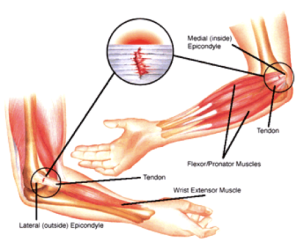Call NOW !+65-8368-7277 or fill in the Form~we will help you arrange a Pro Tennis Coach
All About Tennis Elbow
One of the conditions that may result from playing tennis, tennis elbow is a medical condition wherein the elbows are basically overfatigued, causing severe pain that may radiate to one’s wrists and entire arm. Let’s learn more about tennis elbow, its causes, symptoms, treatment and prevention.
What is Tennis Elbow
Pain in the elbows, known to tennis players as tennis elbows and called by doctors as lateral epicondylitis, happens at the site of attachment of the forearm muscles’ tendons to that of the elbow’s bony prominence. While the term only indicates the condition experienced in the elbows, the pain can actually spread out towards the wrist and also affect the whole arm.
What Causes It
Part of playing tennis and other similar sports is knowing some facts about tennis elbow and how it could happen to you. In tennis players, tennis elbow is frequently caused by applying a wrong technique when attempting to execute a tennis backhand. Wrong execution of a tennis backhand results to the contraction of the forearm muscles in a repeated manner. The muscle tissues are subjected in too much stress, causing inflammation and may eventually create small tears in the tendons at the outside portion of your elbow called the lateral epicondyle, thus the name of the injury.
Aside from tennis, other sports or activities that make use of racquets such as table tennis and badminton may also cause tennis elbow. Driving screws, using tools for plumbing, overusing computer mouse, cutting meat and other tough ingredients, and even painting may also put a person at risk of tennis elbow.
What are Its Symptoms
As mentioned before, tennis elbow’s main symptom is pain that is felt on the outside of the elbow and may also be felt in the wrist and/or forearm. Because of inflammation, redness and swelling of the elbow may also be observed. In addition, weakness of the affected forearm is a symptom of tennis elbow. A player should consult a doctor immediately if he experiences pain when he turns a doorknob, shakes hands, or holds cups. Chronic worsening pain especially when lifting and grasping objects can result from untreated tennis elbow. Tendinitis wrist or inflammation of tennis wrists may also be a complication that indicates worsening tennis elbow.
How Is It Treated
Immediately after you have felt pain on the outside of your elbow, refrain stop your play and get treated using the RICE management. R stands for rest, which means you should not do anything but rest your elbow. I means ice. Get a cold compress to relieve pain and swelling of the affected area. C refers to compression, meaning you’ll have to wrap the injured area using an elastic bandage. E stands for elevation. This means that your elbow should be kept above your heart level to reduce swelling.
After RICE emergency treatment, you may take in over-the-counter pain relievers. Then, seek the help of your doctor who will assess the need for medications and or surgery. He would ask for an x-ray of the affected area. For severe tennis elbow, Magnetic resonance imaging (MRI) or Electromyography (EMG) may be ordered by the doctor. After prescribing pain medications and forearm braces, your doctor would recommend you to a sports therapist for rehabilitative therapy. If in the appointed time (usually one year) your tennis elbow hasn’t improved, you might undergo surgical correction of tennis elbow.
How Can You Prevent It
Tennis elbow can be prevented by means of executing tennis backhand and other strokes with the right techniques. These techniques must be provided by your coach (Qualified) and your execution of such should be monitored and evaluated according. In addition, wearing elbow support such as elbow bands is very helpful in preventing tennis elbow.
TennisCoachSingapore provides qualified coach with either one of the qualification NCAP (Singapore) from SSC (Singapore Sports Council), USPTR (US Professional Tennis Registry Certificate), ITF Play Tennis Course and other qualifications.



